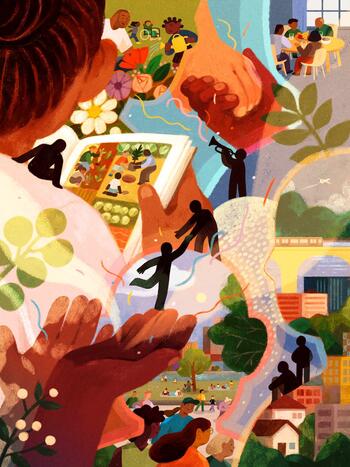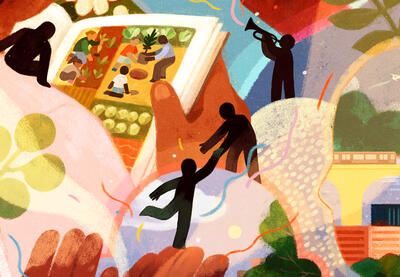Love is often difficult to define and challenging to make sense of in the context of social justice education. Still, many people involved in the beautiful work of teaching and learning for justice have shared extensively about the moral imperative of love in schools, even as our understandings of love differ.
Asset-based social justice pedagogies – such as culturally relevant teaching, culturally responsive teaching, abolitionist pedagogy, culturally and historically responsive literacy, and the archaeology of self – all draw on a series of ideas grounded in love for young people. Many of the education scholars behind these theories have connected the foundations of their contemporary approaches to teaching and loving with James Baldwin’s 1963 “A Talk to Teachers,” in which Baldwin urged educators (and families) to consider what is at stake when we love our students while remaining aware of the consequences for young people (and our world) when we do not love them. Specifically, Baldwin writes about the many social ills he witnessed in the educational realities of Black students in the absence of loving schools and approaches to teaching. Furthermore, he connects the inequities Black youth face with the lack of love they receive in schools due to their racial identity not being affirmed, thus making a point about what is at stake (Black youth thriving) when we do not engage in loving approaches to teaching Black students.
Similarly, Martin Luther King Jr. once said: “Darkness cannot drive out darkness; only light can do that. Hate cannot drive out hate; only love can do that.” This quotation speaks to King’s belief that the appropriate response to hate or anti-Blackness is love of Black youth and their communities. In this way, love again is positioned as the path out of educational injustice and inequity. And although these examples center on Black youth, I believe that love can and must be present in the education of all young people.
Most educators agree that we should cultivate a deep love for students, especially given the educational injustice too many students face in schools today. However, many of these same educators also ask, “What does love look like in education?”
Nurturing Young People’s Well-Being

In Humans Who Teach, I share my understanding of love as “that which moves us to nurture the physical, emotional, and spiritual growth of others and ourselves. That which moves us to interrupt anything and anyone that threatens the humanity of those we love. And that which can be chosen and is always an action.” This definition articulates not only what love means, but also how love informs my life as a human who teaches. It draws on my experiences growing up surrounded by Black women as well as my deep dives into the work and lives of Toni Morrison, bell hooks, and a trio of Black trans women.
Having a clear understanding of love in the context of teaching and learning serves as the basis for “QuestionWork” – my reimagining of the notion of “frameworks,” which can make teaching feel limited and confined. In thinking about a loving pedagogy, the approach of questions in teaching and learning instead of frames feels more useful.
Grounded in love, QuestionWork is composed of five essential questions, key among them being: “As a human who teaches, in what ways does my approach to teaching nurture the physical, emotional and spiritual well being of my students?” This question invites us as educators and family members to think about love as nurturing the well-being of young people both inside and outside of schools. And it encourages us to consider our actions, not merely our words or intentions. In thinking of ways to respond to this essential question, we must further unpack what is meant by nurturing “well-being.” We can think of well-being in three ways: physical, emotional and spiritual.
Physical well-being refers to the many ways we engage in caring for our physical bodies. A few examples include resting, eating nutritious food, exercise and good hygiene practices. And nurturing the physical well being of young people might include helping ensure food access and advocating for accessible health care.
Emotional well-being speaks to the spaces within us that serve as the home of our thoughts, ideas and feelings. Caring for our emotional well-being could involve various forms of therapy, breathing exercises and honoring our feelings as they arise. Simply, emotional well-being involves the ways we make sure we are positioned to have healthy and positive thoughts, ideas and feelings. For example, if we do not attend to our feelings in appropriate and healthy ways, we might have negative thoughts and ideas, and those negative thoughts and ideas become the directions or messages we send to our bodies. Consequently, we engage in activities that are unhealthy or do not lead to us being and staying well. Nurturing the emotional well-being of youth could involve creating spaces in which they can make sense of their emotions and helping increase their access to mental health services.
Spiritual well-being is all about joy. Just as our hearts pump blood throughout our bodies, the spirit pumps joy, energy and motivation. Nurturing our spiritual well-being includes all the things that bring us joy, such as listening to music or spending time with loved ones. These things will vary for each person as we may find joy from different things. All young people benefit when they are physically, emotionally and spiritually well. And research has shown that attending to children’s well-being fosters growth and better positions them to enjoy academic, personal and social success.
Collective Action for Love

All young people are worthy and deserving of love – the kind of love that moves us to nurture their physical, emotional and spiritual well-being.
Loving young people and nurturing their well-being is a collective responsibility for families, educators and communities. This work might not be easy, but it is possible to practice the kind of love that moves us to make sure young people are well. All our lives and communities are improved when we engage in loving on young people together. The following recommendations can help us better support and love the children in our lives.
Collaborate: Often families and educators work separately toward similar goals for young people. We are stronger together, however, and young people benefit greatly when we see one another as sources of support instead of barriers.
Some of the most exceptional examples of collective love and nurturing require intentional collaboration between the many adults in young people’s lives. For example, in one public school in Brooklyn, New York, young people’s well-being is nurtured by a monthly Saturday series in which young people and their communities come together to engage in competitions and activities focused on well-being. These Saturday sessions have included movement challenges for physical well-being, yoga/meditation in the park for physical and emotional well-being, and community movie nights to enhance spiritual well-being by cultivating joy. The adults involved in the Saturday series exemplify the age-old adage, “It takes a village.” They understand that the work of loving young people is rewarding and not without challenges, but these challenges are better navigated when educators and families think deeply about the ways they intentionally collaborate to care for the young people in their lives in ways that nurture their well-being.
A collaborative community approach to love helps redistribute the workload from one group of adults in young people’s lives to all of the adults in their community. Instead of focusing on the many things that make families and educators different, it is helpful to center the shared love we have for young people and let love be our guide. Importantly, collaborations for projects need to start in the planning or ideation stage. Collective endeavors must move beyond educators and schools planning and then inviting families to help execute.
True collaboration involves everyone from the beginning.
The following are some questions that families and educators might consider as they reflect on collaborating to better collectively love on young people:
- What is the best way to communicate with other educators and family members in a young person’s life?
- What is an ideal time to meet with other educators and family members in a young person’s life to plan activities? This may not be during the school day, as many family members work during school hours.
- What do I know about young people’s physical, emotional and spiritual needs? How might I find out what other educators and family members know about young people’s needs?
- What resources do I have to contribute to activities and initiatives focused on young people’s well-being? What resources do other educators and family members have for this same aim?
- How are we making sure that both educators and family members are sharing the responsibility for nurturing young people’s well-being?
Model: Young people are always watching the adults in their lives.
They look to the adults around them to make sense of what it means to be human, how to treat others and how to treat themselves. Therefore, educators and families have the unique opportunity to model the kind of well-being and nurturing we want young people to adopt for themselves. This requires that educators and family members make sure they are nurturing themselves physically, emotionally and spiritually to the best of their abilities.
Families and educators might ask themselves the following questions as they reflect on modeling:
- How am I nurturing my physical well-being or taking care of my body?
- How am I nurturing my emotional well-being or taking care of my mind?
- How am I nurturing my spiritual well-being or ensuring that my life is filled with joy?
- How am I sharing (in explicit and transparent ways) with the young people in my life how I care for myself?
Community Accountability: As a community of adults who love young people, it is helpful to engage in collective or community accountability. This approach to accountability holds us and young people accountable for nurturing their well-being and growth. That is, we all make it our business to check in with each other and young people often and across different spaces about the ways in which the young folks in our lives are being cared for. This looks like all of us asking ourselves:
- How are we doing with regard to caring for young people?
- How do we make sure we are sharing the same expectations with young people about the necessity of caring for their well-being?
- What feedback have we received from young people about our success with this?
The answers to these questions will differ across our respective contexts including our resources, our geographic locations, and the age of the youth in our lives. This process is also ongoing and iterative.
All young people are worthy and deserving of love – the kind of love that moves us to nurture their physical, emotional and spiritual well-being. And we are better together and more effective when we work together rather than in isolation. Let us join in community as we improve the ways we love the young folks in our lives.
